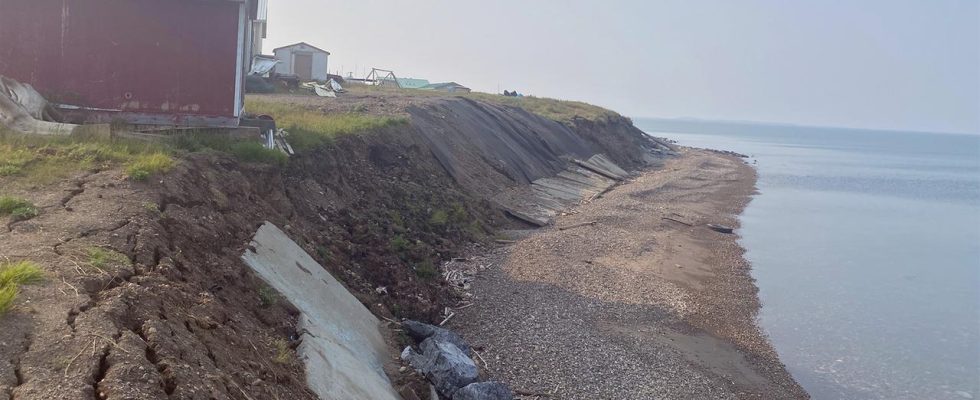world mirror
The Arctic is warming faster than other regions – with drastic consequences for the coastal village of Tuktoyaktuk in Canada. As the permafrost thaws, the ocean wears away the soil beneath houses. People lose their homes.
A huge sheet of ice is melting in the sun, the permafrost above it is melting and sagging, the coastline is eroding. There are few places where the consequences of climate change are as drastic as in Tuktoyaktuk. The church could be the first in Canada to have to completely relocate.
“This is where my house once stood,” says Noella Cockney. She stands on the cliff and points out to sea, where the arctic ocean gently laps at the beach. Nothing reminds you of your home anymore.
The waves gnawed at the ground beneath the building until it became too unsafe to live there. “I couldn’t sleep peacefully anymore,” says the retired police officer. “Especially in the summer, I was constantly worried that the sea would throw debris against my windows and smash them.”
“It’s a race against time”
Noella is one of the first in Tuktoyaktuk to have her house completely relocated. But that should only be the beginning. “It’s a race against time,” says the woman with the soft voice. “In the long term, I think all my neighbors will have to move inland. It’s hard to understand. So many people will lose their homes because of climate change.”
Red, yellow and blue wooden houses line the coast of Tuk, as they affectionately call the place here. Everywhere on the beach smoke rises from small tents – this is where the Inuit smoke their fish.
1,000 people live in the town at the end of the Dempster Highway. It is the only connection to the Arctic Ocean in Canada and to the strategically important port that supplies the western Arctic with goods and food.
Retired police officer Noella Cockney has already had to move her house.
The offshore island breaks away
Dustin Whalen cranks his boat’s outboard motor. Today the head of research plays the chauffeur. He has been doing research here for almost 20 years, now he is bringing a whole team of scientists from Canada and Great Britain over to Tuk Island. This one kilometer offshore island is like a life insurance policy for the port.
But it’s shrinking because the coasts on both sides are eroding – two meters a year. And with temperatures reaching 30 degrees this summer, it’s happening even faster.
The Arctic region is warming four times faster than the rest of the world. “We all know the saying: When I was little, everything was different,” says Dustin. “But now the young people are saying that everything was different last summer. I was able to walk over a sandbank – it’s completely gone now because the ice underneath has thawed.”
Scientists from the Alfred Wegener Institute doing field work in Tuktoyaktuk. They are particularly concerned about the invisible consequences of warming.
Gases rise into the atmosphere
“Be careful,” warns the Canadian as he stands in front of the vast field of deep match and torn pieces of tundra. “It’s best if you jump from patch of grass to patch of grass.”
Here you can experience coastal erosion up close and hear large chunks of earth slamming onto the ice. Below is a brown soup of melted permafrost, up on the cliff a meter thick ice sweating unprotected in the sun. “Here the permafrost has thawed – and exposes the ice,” the researcher points to the ice sheet. “A visible impact of climate change.”
What worries Dustin even more are the unseen consequences. As soon as the permafrost thaws, bacteria become active and decompose the matter. This produces greenhouse gases, such as methane.
“It’s like a freezer where you pull the plug,” explains permafrost researcher Paul Overduin from the Alfred Wegener Institute in Potsdam. “If you open it two weeks later, it stinks.” These gases go into the atmosphere and can change the climate worldwide.
The open permafrost at Tuktoyaktuk. Above is earth and tundra, below is earth mixed with frozen water, and below is a thick layer of ice. As the ice thaws, this layer gradually melts away and everything above it sags.
Government pledged millions for coastal protection
Noella Cockney was lucky: her red wooden house could be completely relocated. It was transported inland to a safe place in winter via an ice road. But what about the many others who live right on the water in Tuk?
The government has just pledged more than 53 million Canadian dollars for coastal protection. “But that will only save us for the next 30 years,” says the Inuit woman.
The coast of Tuktoyaktuk. It is not unlikely that the place will have to completely relocate in the next few years.
Her concern: If a severe storm comes beforehand, with flooding and destruction, then the place could no longer be relocated as easily as her house.
She misses the soothing sound of the gently lapping waves. But since she’s been living here, Noella can finally sleep peacefully again.
You can see this and other reports in the Weltspiegel – on Sunday, August 27th, 2023, at 6.30 p.m. in the first.

